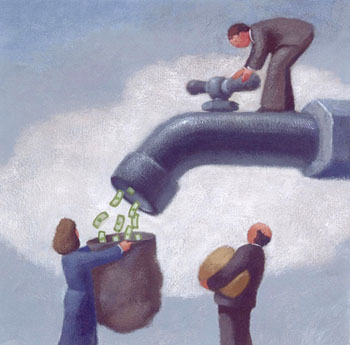 Breaking the Obama Code: The Green Money Machine
Breaking the Obama Code: The Green Money Machine
FROM-
American ThinkerBy Patti Villacorta
As a few dozen dot com billionaires gathered in a Palo Alto living room one evening in early 2007, then-Senator Obama rallied potential new donors over the speakerphone. After the call, the host John Roos, a prominent lawyer, emphasized what most of his guests already knew. The clean-energy revolution was gaining momentum. The election in 2008 would be the critical moment. The ethics-based green revolution could be passed into law and Obama was their guy. Roos raised much money and opened many doors for Obama that evening. In May 2009, despite initial
criticism from Japan, Roos was given the plum appointment of U.S. Ambassador.
Roos, who had handpicked his guest list carefully, was a kingmaker in the progressive, green, and Bay Area billionaires club. The polls showing America's rising concerns about ocean levels reflected the hard work of Silicon Valley hedge fund managers and venture capitalists.
The Obama Exploratory team had formed and the candidacy announcement was scheduled for early February. But Jude Barry, a political strategist and software programmer, wasn't one to hedge his bets. In late December of 2006 he quietly filed paperwork and created Obama for America Draft Committee (FEC ID #C00431130).
Jude Barry is one of many Howard Dean loyalists who helped Obama win the White House. Once labeled as a "self-styled Machiavellian apparatchik" by the San Jose political press, Barry helped develop Dean's net roots campaign that unraveled with a scream in Iowa. Still, the political landscape had been changed forever by Barry and fellow Deaniacs including Christopher Edley, UC Berkeley Law School Dean, Patrick Gaspard, Obama's political director, Jeremy Ben Ami, former Clinton staffer and founder of the anti-Israel J Street, and assistant attorney general Ron Weich.
Co-founder of Catapult Strategies with Dean Campaign manager Joe Trippi, Barry became well known in Silicon Valley political circles where he grew up and attended Catholic school with another assistant attorney general: Tony West. West is the Bay Area lawyer recently revealed as defense attorney for American Taliban John Walker Lindh.
Barry collected six $5000 donations from 12/28/06 and 12/30/06, including one from eBay millionaire Tom Adams III. At the same time Steven Churchwell, a partner at DLA Piper LLC's Government Affairs Group in Sacramento, listed himself as PAC Treasurer. Churchwell's bio states he "assists clients through the challenging waters of California government and politics." Areas of concentration include Ballot measures, Internal Investigations, and PAC regulations.
Obama's courtship with the high-tech crowd had begun back in early 2005. Within weeks of his swearing-in, the new United States Senator launched his Hopefund Pac then flew west to mingle. At the time, Jude Barry was managing Obama-backer Steve Westley's gubernatorial primary against Phil Angelides, the national chair of the Apollo Alliance. Other Apollo Board members include Dan Reicher, Google's Director of Climate Change, Robert Redford, and Van Jones, Obama's ex-Green Czar. Jones worked on Arianna Huffington's brief run for governor.
Obama scored big. Eileen Chamberlain-Donahue, wife of eBay CEO John Donahue took a liking to Obama. She went on to become Chairwoman of the National Women for Obama Finance Committee, and won an invitation to watch his Denver speech from a luxury suite with Penny Pritzker and Oprah.
By November 2006
Hopefund had raised $2.5 million. Some of Obama's early donors include the Warren Buffetts, co-founder of Espirit clothing company Susie Buell, Steven Spielberg, Attorney General Eric Holder, FCC Chair Julius Genachowski, Christina Romer, the Chair of Obama's Council of Economic Advisers, Craig's List CEO Craig Newmark, David Geffen, as well as Jon Gruber, the MIT economist criticized recently
for failing to disclose HHS consultancy contracts.
Edward Robinson's piece on fundraising scene in the wealthy Bay Area points
out:
Venture capitalists ... are struggling with an investing climate that's the
gloomiest since the bust of 2000 and '01. In the first half of 2008, only five venture-backed companies went public ... the poorest showing in five years. ``Almost everybody who's been in the Valley for any period of time is pursuing cleantech now,'' says
Dixon Doll. .
That's where VCs see Obama coming in. In his policy proposal, the senator pledged to invest $150 billion over 10 years to develop solar farms in the Sunbelt, plug-in hybrid cars that get 150 miles per gallon (64 kilometers per liter) and clean coal that doesn't spew carbon.
Obama knew he needed California to win and green billionaires knew they needed Obama. A new loophole, the Unauthorized Independent Expenditure (IE), could make it happen. IEs can spend and raise unlimited money as long as there is no coordination with the candidate. An IE at its most brazen is SEIU's Committee on Political Education (SEIU COPE), formed in order to raise $26,009,685.53 in support of Obama, and $3,163,276.29 to oppose McCain.
The 2008 report "Independent Expenditures: The Giant Gorilla in Campaign Finance," reveals million dollar contributions and multi-million dollar expenditures are common. Californians for a Better Government (CPG), the highly
controversial IE formed for the Angelides' campaign collected $10,015,643 with $8.7 million coming from one pocket: Sacramento developer Angelo Tsakopoulous and his daughter Eleni Tsakopolous-Kournalakis. Married to the President Emeritus of The Washington Monthly, Ms Tsakopolous-Kournalakis
now serves as Ambassador to Hungary.
CPG hired Steve Churchwell as Treasurer just as Obama for America Draft Committee would a few months later. Churchwell landed at the
center of a probe involving incorporation irregularities. The Barry/Churchwell team continues making news. Along with a cryptography and electronic signature expert, they recently unveiled Verafirma Inc, then filed suit requiring San Mateo Superior Court to accept electronic signatures on an initiative petition.
Although Angelides lost to Schwarzenegger, he received a campaign donation from Paul Pelosi (Nancy's husband). In January 2009 Angelides delivered billions in stimulus money for Apollo's
big, "new" green revolution initiative. First unveiled at a 2006
Conference co- sponsored with Bob Borosage, Angelides' friend from Jesse Jackson's campaign, Apollo's green revolution themed conference featured Kerry, Edwards, Dean, Obama and others vowing to take the party back from the centrist DLC.
In May 2009, Nancy Pelosi and Harry Reid selected Angelides to chair their Financial Crisis Inquiry Commission (FCIC) tasked with investigating the cause of the 2007-2010 financial crisis. The Angelides pick prompted complaints of conflicts-of-interest mainly around issues like pension funds. Strangely, his seat on the Board of the Climate Prosperity Alliance (CPA) went unmentioned.
CPA describes itself as a "global network of financiers, businesses, economic development authorities, scientists and NGO's." Marc Weiss, CPA Chair, served as Special Assistant to Andrew Cuomo and Henry Cisneros under Bill Clinton. CPA endorses the expansive policies of the U.N. General Assembly's 2009 'Global Green New Deal.' CPA also advocates $1 trillion of green investments per year in order to "re-deploy assets" and solve worldwide financial instability."
Weeks before falsified documents surfaced confirming global warming as little more than another far-left power grab, a CPA
report celebrated $1,248,740,645,930.00 invested since 2007. The monies came from finance institutes and corporations in North America, Europe, China, India, Japan and Brazil.
Welcome to the ethics-based global revolution. The tangle of corrupt, hypocritical liars is made far worse by the growing realization of just how badly America was duped.
More...



















